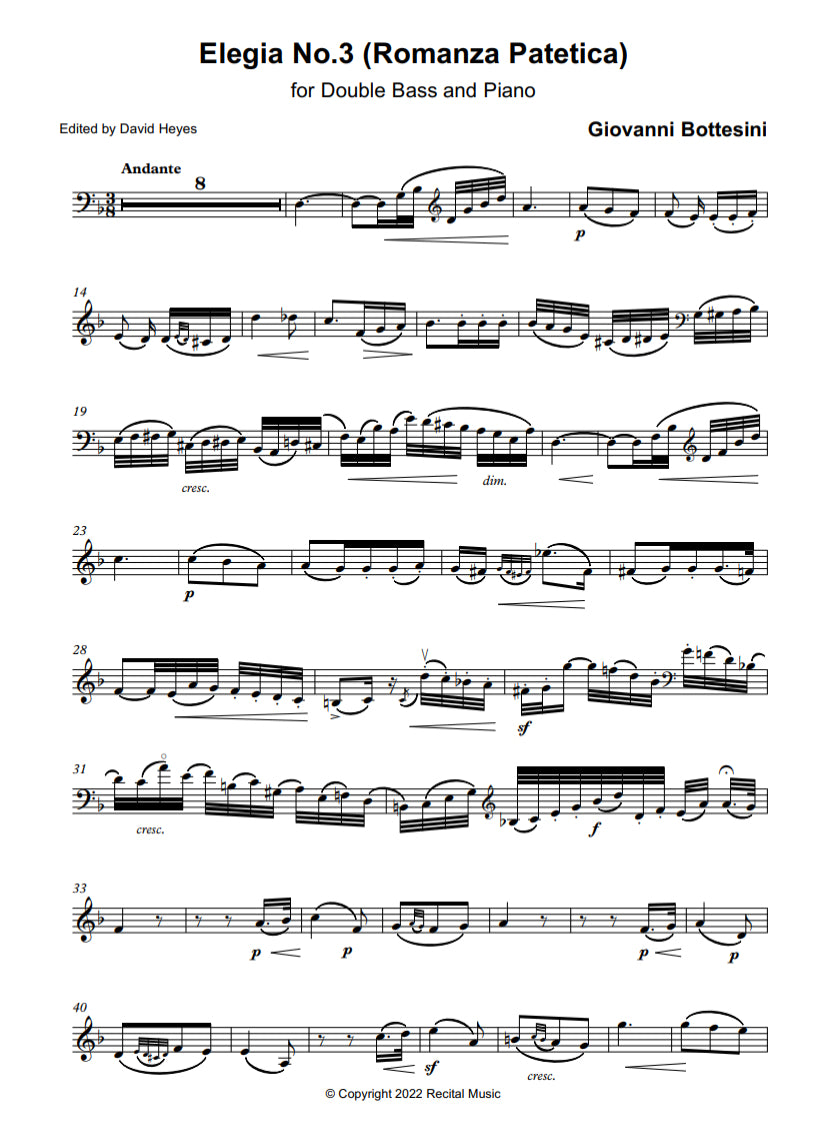David Heyes
Bottesini: Elegia 1, 2, & 3 for double bass and piano (edited by David Heyes)
Bottesini: Elegia 1, 2, & 3 for double bass and piano (edited by David Heyes)
Couldn't load pickup availability
About the Collection
Elegia 1, 2 & 3 by Giovanni Bottesini demonstrate a composer at the very height of his powers. Each offers musical and technical challenges in equal measure, demonstrating the virtuosic and lyrical potential of the double bass throughout its solo register, and the beauty and quality confirm why Bottesini’s music is still at the heart of the solo repertoire more than 130 years after his death.
Elegia No.1
Was first published in Bottesini's Grande méthod complète de contrebasse (c.1869) to illustrate the lyrical capabilities of the instrument, and was rumoured to be the composer's favourite work. It has been recorded more than any other work by Bottesini and is one of his most attractive and accessible pieces for double bass.
Elegia No.1 is aimed at the intermediate bassist, offers musical and technical challenges in equal measure, and is an ideal ‘easy’ virtuoso work for bassists who are venturing into the higher reaches of the instrument. This edition returns to the version published in Bottesini’s Grande méthod complète de contrebasse, presumably corrected and edited by the composer.
The edition is published with piano accompaniments for both solo and orchestral tunings and also includes two double bass parts - the original bowings by the composer and a newly edited part by David Heyes.
Elegia No.1 is also available for solo double bass and string orchestra in both solo and orchestral tunings.
Elegy No.2 (Romanza Drammatica)
Has a completely different character and style to Bottesini's other elegies, with a dramatic and serious intent that exploits many lyrical and sonorous possibilities of the double bass.
The opening theme is sensuous and evocative, suffused with the operatic flair and dramatic potential of the mid-19th century. Bottesini always exploits the technical challenges in a musical way, using powerful and dramatic double stops and harmonics to add variety and contrast, but the overall character is one of great beauty and elegance.
The bass-friendly keys of D minor and D major are used, offering many harmonic and dramatic possibilities. The minor key is wistful and reflective contrasting music of a more dramatic, optimistic, and technical nature in the tonic major, but this is Bottesini at his most serious and wistful.
Elegy No.2 is not as showy as many pieces by Bottesini, but it allows the advanced bassist to demonstrate both a technical and musical prowess alongside the ability to exploit the lyrical, cantabile, and dramatic possibilities of the solo double bass.
This edition includes accompaniments for both solo and orchestral tunings and two solo parts - Bottesini’s original bowings from one manuscript source and one edited by David Heyes.
Elegia No. 3
Also known as Romanza Patetica, was first published by Richault in Paris in 1879 with the title Mélodie, and is one of Bottesini’s most sublime pieces for the double bass. Probably composed in the middle 1870s, it emphasizes the lyrical and sonorous possibilities of the double bass across its entire solo register.
The use of D minor/major, sounding E minor/major for solo tuning, offers dramatic potential with the ability for the double bass to be as expressive and eloquent as the cello or violin. Although primarily in treble clef, the melodic line descends to open A, Bottesini’s lowest note, rising to high D in harmonics, one of the highest notes available to the double bass.
Elegia No. 3 is a perfect piece, ideal for any audience or occasion, and demonstrates the technical and musical prowess of the bassist. It emphasizes Bottesini’s supreme compositional skills and why his music is still at the heart of the solo repertoire into the 21st-century.
Accompaniments for both solo and orchestral tunings and two solo parts - Bottesini’s original bowings from one manuscript source and one edited by David Heyes.
About the Composer
"How he bewildered us by playing all sorts of melodies in flute-like harmonics, as though he had a hundred nightingales caged in his double bass... I never wearied of his consummate grace and finish, his fatal precision, his heavenly tone, his fine taste. One sometimes yearned for a touch of human imperfection, but he was like a dead shot; he never missed what he aimed at, and he never aimed at less than perfection." [H.Haweis, 1888]
Giovanni Bottesini (1821-1889) was the greatest double bass virtuoso of the 19th- century, and many of his compositions for double bass are still at the heart of the solo repertoire today. He spent much of his life in the opera house as a conductor, and composer and his music is inspired by the lyrical, cantabile, and virtuosic pyrotechnics of 19th-century Italian opera. Bottesini was known as ‘the Paganini of the double bass’ and was one of the greatest musical superstars of his day.









